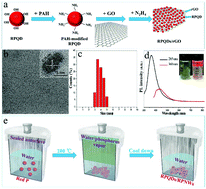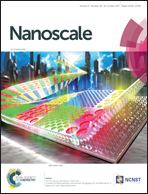Engineering graphene with red phosphorus quantum dots for superior hybrid anodes of sodium-ion batteries†
Abstract
Red phosphorus (P) has been considered to be one of the most promising anode materials for sodium-ion batteries (SIBs) because of its highest theoretical capacity (∼2600 mA h g−1). For the first time, we report a reliable hydrothermal method for the preparation of red phosphorus quantum dots (RPQDs) with commercial red P as a source. Moreover, an effective strategy was designed to fabricate RPQDs/rGO nanohybrids for addressing the intrinsic issues of red P as anode materials for SIBs. Benefiting from the nanostructuring of red P and the coupling of RPQDs with rGO, the obtained nanohybrids not only promote electron and ion transfer, but also effectively enhance the electronic conductivity, restrain the aggregation of RPQDs and buffer the large volume changes of red phosphorus during the charge–discharge process. The nanohybrids deliver an initial specific capacity of 1161 mA h g−1 and a low capacity deterioration rate of less than 0.12% per cycle even after 250 cycles at a current density of 200 mA g−1. The feasibility of large-scale production of the RPQDs/rGO nanohybrid, associated with its outstanding Na-ion storage properties and low cost, demonstrates that the RPQDs/rGO hybrid is a very promising anode material for SIBs.



 Please wait while we load your content...
Please wait while we load your content...